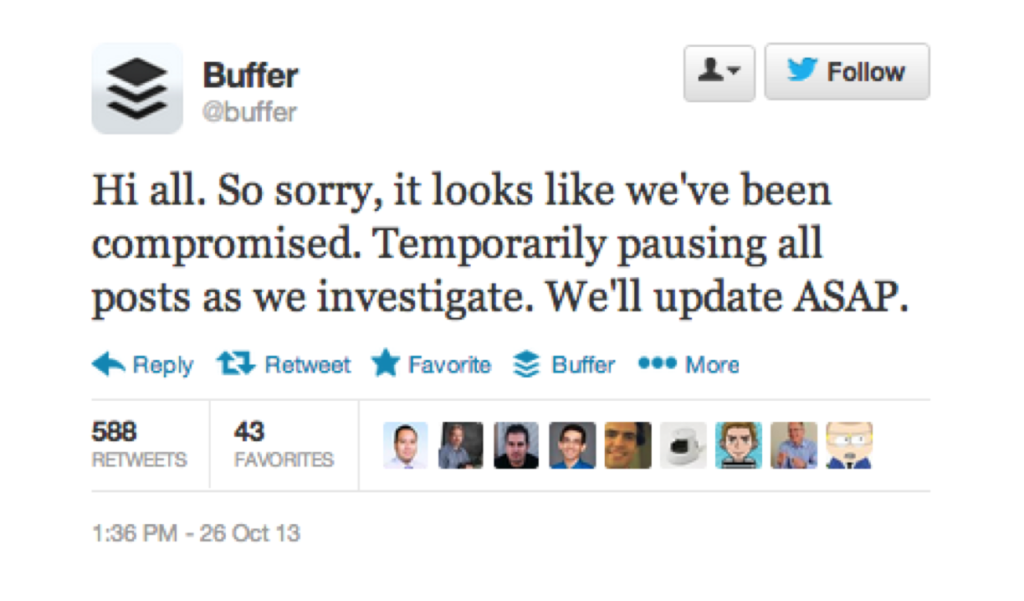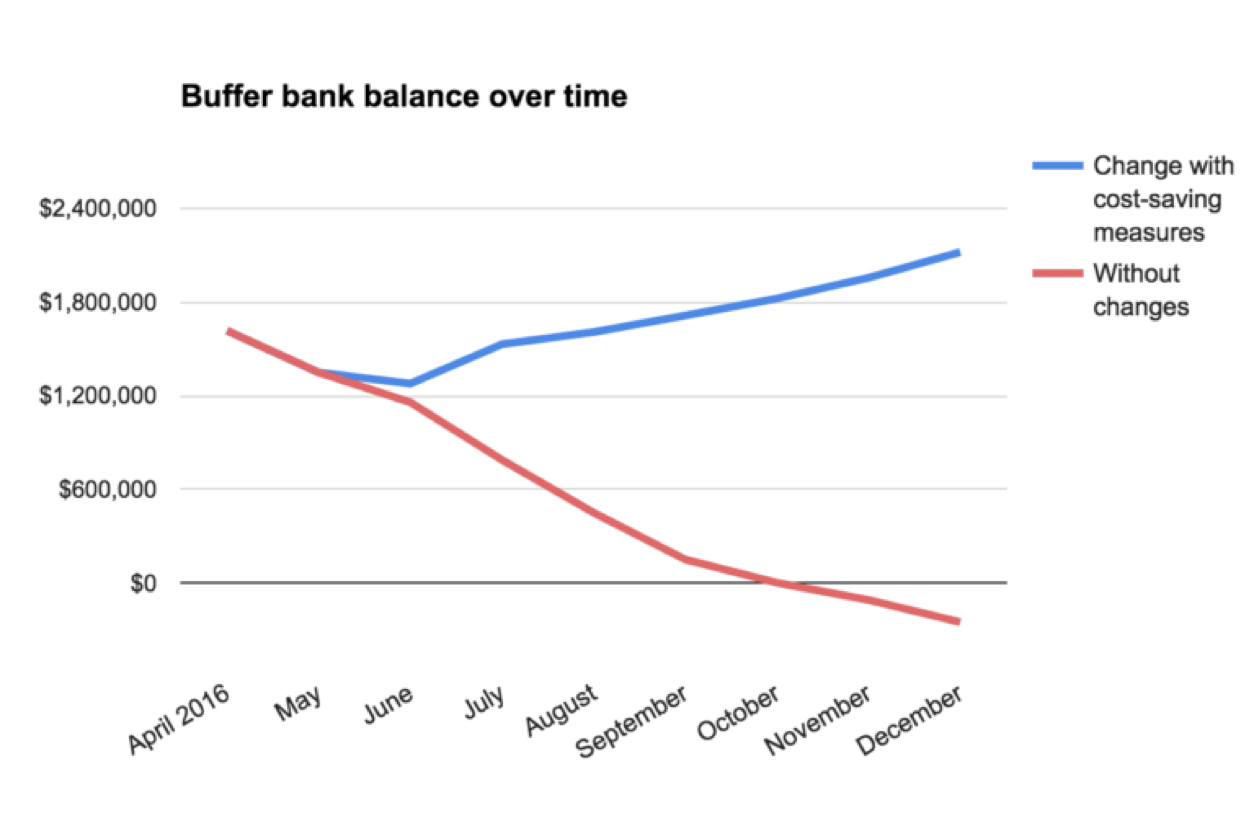
3 Breakthroughs and 2 Failures that Have Shaped Buffer
In Buffer’s past six years, we’ve experimented with product and culture and had some successes and some flops.
And yet there have been some breakthroughs that evolved naturally, some intentionally. On the flip side, we’ve had some failures that have been outside our control and also fully within our control.
Each up and down has shaped us as a company, as a product and me as an individual.
Here are a few of those breakthroughs and failures.
Breakthrough #1 – Living and working transparency
At Buffer, we’re completely open with our salaries, equity, revenue, diversity, and so many more things!

One day, I interviewed an engineering candidate and I asked them “Why do you want to work here?” and he said, “Because I know more about your company, than the company I currently work for. That’s why I want to to work with you!”
That really stuck with me.
Sometimes people ask “Why are you so transparent?” I believe it’s one of the greatest philosophies we’ve adopted at Buffer.
The reason we’re so transparent goes back to the idea that Joel and I, in the very early days of Buffer, felt that to have fulfilling lives, we wanted to be open and share the good and bad with the world. We wanted to always assume that people are good and worthy to be trusted with information.
And that’s still our fundamental belief.
We’ve had a lot of good things happen to us because of transparency:
1. Help from others: Very early on, we started to publish our monthly growth and finance updates. We had really a very poor understanding of things like MRR (monthly recurring revenue) and ARR (annual recurring revenue) and ended up reporting it wrong completely!
And people in the comments not only pointed it out, but said “Hey, this is how you need to calculate it instead.” And that was really incredible – we’ve learned that from being so transparent, we have hundreds, sometimes thousands of experts who share their opinions and help us get better.
2. More potential teammates: Before we made salaries transparent at Buffer, we were really scared.
A lot of people told us it was a stupid idea to make salaries transparent. On the evening before we hit publish, we prepared ourselves for a big backlash.
An hour after publishing, exactly the opposite had happened.
We had over 100,000 people who checked out our salary formula blog post. On top of that we also received more than 4,000 applications.

People were positively overwhelmed with our commitment to transparency and its contribution to trust and equality in pay. We were absolutely blown away.
3. Effortless accountability: We’re looking for a VP of Finance right now at Buffer and last week, we made an offer to someone. The question of bonuses came up, which is a totally reasonable thing to ask for.
Right now, we don’t have any bonus systems at Buffer. And I said “That’s a great idea. We don’t have a bonus system in place right now, but would you like to come in and build a transparent, fair bonus system across the entire company with us?”
I think of this effect as “effortless accountability.” Transparency keeps us in line to keep integrity high and avoid making decisions that might leave some people disadvantaged.
Breakthrough #2 – Working remotely
We believe the future of work is remote.

At Buffer we’re completely remote. We don’t even have a physical office location. We have 80 team members spread across 5 continents, from Sri Lanka to South Africa to Taiwan to Singapore to the Netherlands, and all over Europe, Canada and the U.S.
We fundamentally believe that it’s a good idea to travel, explore the world and live where you’re happiest. And when we wrote that down, we decided we wanted to extend that to everyone who joins Buffer.
So you can live and work anywhere in the world and still be part of Buffer. We call this avoiding the “deferred life plan.”
What does this look like in practice?
Several of our team members have been living as digital nomads, traveling for a year or more.
Here are a few images from Daniel, who has lived in New Zealand, Australia, Hawaii, England, the Netherlands, and San Francisco in the past year and a half.

Matt, a data analyst, has embarked on a journey to travel the western United States while working from the road with his wife and two dogs. (We’ll share more updates on Matt’s journey here on the Open blog!)

For some, being remote means the opportunity for travel. For others, it means the opportunity to stay at home with their kids.
I remember one team member who came up to Joel and me at one of our in–person retreats with tears in his eyes and said, “Thanks for what you’ve done for me and my family.”
Here is Nicole, with her son, Anthony, who was the first “Buffer baby” on a Zoom video chat. In 2016, we’ve been very lucky to welcome many more babies to the team!

We’re keen to create a place where people can work and live the life they want to live.
Working remotely does require a different mindset and quite a lot of tools. More than six years ago, I might have been hesitant that a company could work fully remotely. But today, we have a wide variety of tools that make communication more seamless.
Some of our main tools include:
- Trello (for project management)
- Slack (for instant messaging)
- Zoom (for video conferencing)
- Dropbox (for syncing documents and files)
- Paper (for a-synchronous collaboration)
- Discourse (for forum-type discussions)
We use these tools and more to keep in touch, share projects and work asynchronously. (We also put a huge emphasis on team-building through a variety of remote-methods!)
Breakthrough #3: Building a culture-first company
Tony Hsieh, the CEO of Zappos, was once asked, “What’s one thing you would have changed if you were to start Zappos today?” He responded that he would have come up with company values from Day One.
His answer really surprised me, because that was the exact thing we felt. A little over a year into building Buffer, when we were still just 8 team members we set down our first set of 10 company values. In that way, I consider Buffer a culture-first company.
And then it kind of gets ugly. A few months after we put our values down in writing, we’d fired half the team.
Culture is often a nice, fluffy, comforting term, but often it’s a lot more about honesty, discipline and integrity. If you follow those traits through to their core, you have to make some tough calls.
In a way, culture is like a disinfectant – it hurts a lot, but you end up being a lot stronger. Especially once you make your values explicit.

You can’t turn away from the truth anymore, or your values will be nothing more than a piece of paper taped to the wall. Once you make your values explicit, acting on them is the most important thing you can do.
When I talk with other companies about values, I don’t ask “What are your values?” Instead, I like to ask “What changes did making your values explicit trigger or do they trigger on an ongoing basis?”
At Buffer, we took a really hard look at all of our actions. We realized that some of the things we were doing and also some of the people we had on our team weren’t in line with the culture and values we had just written down.
So in a span of a few months, we had some really thoughtful discussions and the team shrunk from 13 to 8 people.
Those months were some of our toughest, but it also felt right to take these steps. We learned that if you can survive that initial disinfectant, you can likely survive any challenge that comes afterward.
(I should mention that values matter a lot more after you reach product–market fit. You can read all about how we created ours here.)
Culture makes you “anti-fragile,” as Nicholas Tassim Taleb describes in his book. When Buffer got hacked, our values and strong culture didn’t just help us recover, they allowed us to turn that tough event into a positive.
Culture is our plan for uncertainty. Things are guaranteed to go wrong sometimes, but a strong culture creates a certain elasticity among the team. The next small bump or huge hurdle will impact us, yes, but the resilience will allow us to absorb these shocks.
The other side of the coin: two failures that have shaped us as a company and team
Even in instances that might be called failures, there are lessons to be learned.
There’s this idea that I like from Thich Nhat Hanh and his book, No mud, no lotus, that you can turn seemingly bad things into something good.
These examples are Buffer’s mud. From each of these, however, came a lotus or two.
Failure #1: That time we got hacked
I recently read a piece from Jeff Bezos on Amazon’s failed Fire phone. People asked him whether he’s worried about that failure and he said, “If you think that’s a big failure, we’re working on much bigger failures right now.”
When you start to tackle big things, whether it’s culture or product, you’ll inevitably create your fair share of failures. And in Buffer’s transparent spirit, we think it’s worth sharing those too.
You know that feeling when your heart hits your stomach? That’s what it felt like to realize we got hacked.
The hack involved spam posts being sent out to our users accounts. This was a really hard one, we had to act quickly to solve the problem while communicating with out community, all remotely.
While we were trying to block off the attackers and secure our users tokens for Facebook and Twitter, we also had to be on top of communicating all of this to our users and community.
We immediately sent out posts on Twitter and Facebook and then kicked off a blog post that we live updated, and also monitored the comments. We over-communicated until everything was resolved.

So what was our mistake here?
We were guilty of storing certain secrets within our codebase and unencrypted access tokens in our database. The attackers obtained these two pieces and from there out and that’s that. We also didn’t require two-factor authentication (TFA) to be set up for all of our team services.
In the aftermath, we invested a lot more in security. Our Chief Technical Officer, Sunil, says security is a mindset; not a one-time event.
Two-factor authentication was a big part of this. Today, every Buffer team member sets up TFA for every service that we use that supports it. For services that do not support TFA, we’ve made sure that all passwords are non-shared and unique, ideally using a service like OnePassword or LastPass. (Here’s also a great resource on setting up a secure password.)
Following the security breach, we’ve made sure that Buffer offers two-factor authentication primarily for this reason.
We were lucky to get the chance to restore our community’s trust in us by putting in the work and keeping everything out in the open.
Failure #2: When we had to make layoffs
In May of 2016, we realized we’d made a terrible error in our accounting and financial projections and made a series of financial cuts, including the painful decision to lay off 10 of our team members.

These layoffs taught us the true difference between growing a product and growing a company.
When building a product, you can make mistakes and just fix them. Experiments fail all the time, and we know the product will bounce back. Our mindset was that if we spend more, and it doesn’t work, we’ll fix it.
The problem was, that we were building a company, not just a product. If these experiments failed, it involved people’s lives.
Joel and I got something wrong with how we set up our financial modeling. Things weren’t adding up, and the solution was letting go of people, which is very different from killing a feature.
This experience fundamentally changed my viewpoint. I realized that we need a different level of scrutiny and time spent thinking about these types of problems.
The biggest changes we’re making is getting help. We’re hiring a strong leadership team and bringing in key roles like a vice president of finance and a vice president of product, whereas in the past we’ve let leaders emerge naturally from within Buffer.
We’re not doing this because we think we are incapable of running the company, but so that we can bring in more diverse perspectives to help make better decisions that keep the company growing and avoid costly and hurtful mistakes.
There are so many ups and down in a startup and high-pressure environment. At the end of the day, each of these experiences has played a key role in shaping Buffer into the company you see now.
I’m grateful to be able to share all of this and ready for what the future holds.
This is a slightly modified version of the presentation that I gave at TNW Conference in New York. Here is the full slide deck:
And here is a video of the presentation!
Over to you
Do any of these stand out to you? Have there been any breakthroughs or failures that you’ve learned from in your journey? We’d love to hear your thoughts in the comments!
Try Buffer for free
140,000+ small businesses like yours use Buffer to build their brand on social media every month
Get started nowRelated Articles

In this article, the Buffer Content team shares exactly how and where we use AI in our work.

With so many years of being remote, we’ve experimented with communication a lot. One conversation that often comes up for remote companies is asynchronous (async) communication. Async just means that a discussion happens when it is convenient for participants. For example, if I record a Loom video for a teammate in another time zone, they can watch it when they’re online — this is async communication at its best. Some remote companies are async first. A few are even fully async with no live ca

Like many others, I read and reply to hundreds of emails every week and I have for years. And as with anything — some emails are so much better than others. Some emails truly stand out because the person took time to research, or they shared their request quickly. There are a lot of things that can take an email from good to great, and in this post, we’re going to get into them. What’s in this post: * The best tools for email * What to say instead of “Let me know if you have any questions” a